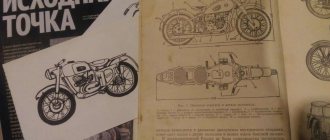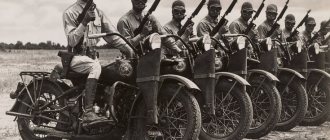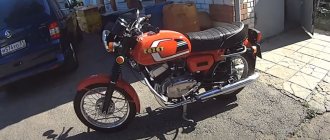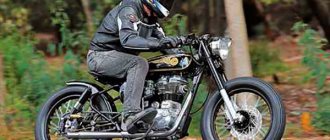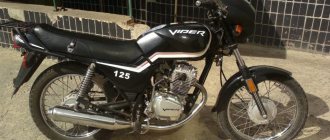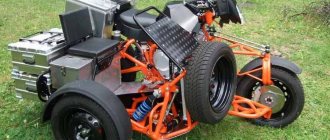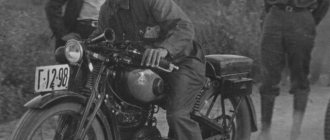It's the May holidays and as a tribute to the feat of our ancestors, I would like to review the motorcycles that took part on the front line and in civilian life. What else, besides motorsports, is developing the motorcycle industry? War and the arms race spurred the development of motorcycles, because even one motor unit can change the course of history.
By the time the Second World War began, German motorcycles had an advantage, so we will begin our review with them.
Let's remember the history course. After the First World War, Germany was humiliated and, according to the treaty, it did not have the right to develop the defense industry to its fullest extent. Citizens of the country could not buy cars that were quite expensive at that time, but a motorcycle was affordable for any ordinary resident of the destroyed country.
The development of motor vehicles received a strong impetus. BMW and the then popular Zundapp entered into competition for primacy in the new market.
BMW switched from the railway spare parts market, and Zundapp, before developing motorcycles, was engaged in the manufacture of projectiles and detonators.
BMW motorcycles
Until 1924, BMW produced civilian motorcycles, the engine of which was copied by the English boxer Douglas, but closer to the 1930s the motorcycle began to acquire familiar features. It was by this time that BMW presented a new modification, called the R32, and the first real military development was the R35.
New items introduced into the design of motorcycles by the 1930s. years:
- Cardan drive instead of chain drive. The cardan is more convenient and safer under military load conditions, requires less cost and wears out less chain
- Telescopic front fork and fork with hydraulic shock absorbers
BMW motorcycle models:
R35
R12
R66
R71
R75
BMW motorcycles were developed with different configurations for transporting weapons, ammunition and transporting the wounded. Separate versions were motorcycles for motorized troops and patrol police. The motorcycles had cases, mounts for guns, even cases for a machine gun. They were distinguished by their large carrying capacity and repairability, and were produced both with strollers and solo singles.
BMW has proven itself to be the best, and even made a splash with the R71 model, which has become universal and one of the most popular.
FN M12
The FN company in Liege has been selling civilian motorcycles to the Belgian army since the First World War. Following the release of the M86 in 1936, the Belgians decided to develop a model specifically for military use.
FN M86 Super Sport 1937. Civilian version of the FN M12 model
The M12 was significantly better than the M86. It was equipped with a sidecar with machine gun mounts at the front and rear. A more powerful engine compared to the base model drove both the rear wheel and the sidecar wheel. Thanks to the presence of reverse gear, the motorcycle could maneuver well even in small spaces.
CZ 175
This is one of several similar motorcycle models created for the Czechoslovak army in the 1930s. The single-seater CZ 175 was not powerful at all - it was rather designed as a lightweight, maneuverable model that could be easily controlled even on rough terrain. Only the front wheel had suspension.
Model 1939 CZ 175
Zundapp motorcycles
KS600
KS750
Zundapp motorcycles, which were more expensive to manufacture, became part of the German army in 1940. The KS750 became one of the most powerful representatives of the Wehrmacht motorcycle troops. The all-terrain model could cross small water obstacles with the engine completely submerged. But the dive had to be short so that the motorcycle would not choke.
The adjustable suspension made it possible to adapt to the difficulties of the route. A sidecar drive and a spare gas tank filter, the essence of which is to help the motorcycle move even with a broken tank.
Zundapp went bankrupt in 1984, but is remembered as a manufacturer of military off-road motorcycles.
Puch 800
Many of the motorcycles used during the war were civilian models that were simply repainted by the military. One example of this approach was the Austrian motorcycle Puch 800, which the army purchased directly from the factory for its own needs. Its most unusual feature was a small engine mounted across the frame. Usually the motorcycle was equipped with a sidecar.
Kattenkrad aka Sd. Kfz. 2
The tip of the iceberg among high-torque motorcycles. Kattenkrad - a tracked motorcycle with a one and a half liter Opel engine replaced the main horse-drawn force, dragging heavy guns and even airplanes. The most heavy-duty type of motorized transport in the enemy army. The obvious disadvantages of this development were difficulties in passing diagonally on a hill, an extremely uncomfortable landing and seat height, due to which the pilot had difficulty leaving his seat in case of trouble. And the Kattenkrad turned over quite often, especially on sharp and sharp turns.
Excelsior Welbike
The British Welbike had a very unusual design. In order to make airborne troops more mobile, the model was made small enough that it could be packed into a container and dropped by parachute. The result was an extremely inconvenient motorcycle with tiny wheels and a low-power engine of only 98 cc. cm. The seat and A-pillar were folding.
Excelsior Welbike
The Welbike could not carry any equipment at all, it was almost useless on rough terrain, and the motorcycle was also unsuitable for tall paratroopers. The military quickly abandoned the motorcycle, but soon after the war it began to be used in civilian life as a relatively cheap and easily portable means of transport.
DKW - Dampf Kraft Wagen
The Germans came up with their own abbreviation for the motorcycles of this company - Des Knaben Wunsch or, Das Kleine Wunder, which translates as “boys’ dream” and “little miracle”.
Small and nimble motorcycles in the ranks of the German army, with modest dimensions and small engine volumes, became very popular outside the front for their size and efficiency.
RT125
NZ350
The overall result: the consequences of the First World War laid fertile ground in Germany for the successful development of the motorcycle industry and a whole niche of this type of transport. By the beginning of the Second World War and at the height of the conflict, the motorcycle industry had entered a new stage of development, improving the cross-country ability, endurance of equipment and repairability in conditions, as they say - on their knees.
Norton 633
Norton 633.
The Norton 633 was a more powerful version of the 16H. Designed to be fitted with a sidecar, it was the only British military motorcycle to be powered by a sidecar wheel. This stroller did not look like a civilian one, but was essentially an open “box”, devoid of protection from weather conditions. It had a Bren machine gun rack and was sometimes used as a weapons platform.
Cushman Airborne scooter
Cushman Airborne Model 53
Cushman scooters appeared early in the war and were intended for visitors and employees at large US military bases. Since this model had proven its usefulness, a new version was released in 1944 for use by airborne troops. Like the Excelsior Welbike, the Cushman Airborne was parachuted and reassembled on the ground after landing to make paratroopers more mobile. Some models did not have headlights, but the Cushman was more efficient than the Welbike.
Harley-Davidson WLA
Harley Davidson WLA 45
A slight modification of an existing civilian motorcycle, the WLA Harley-Davidson was a popular bike among the US military, who used it for police work, reconnaissance and communications. Its headlights were modified from the civilian model to meet military standards, and the WLA was equipped with special brackets for carrying machine guns. Considering that it could reach a speed of 105 km/h, it was one of the fastest motorcycles of the war.
Yuri Pasholok. Heavy motorcycle for the French cavalry
Home » Cars » Yuri Pasholok. Heavy motorcycle for the French cavalry
Cars
byakin 12/23/2021 695 0 comments
13
in Favoritesin Favoritesfrom Favorites 8
Yuri Pasholok. Heavy motorcycle for the French cavalry
A story about the heavy French motorcycle Gnôme & Rhône AX 2-RM, which was presented at the “Motors of War” exhibition
One of the types of military equipment, without which it is very difficult to imagine the Second World War, is the motorcycle. Nowadays, army motorcycles have become a rarity, since their functions have been taken over by other types of wheeled vehicles. This trend began during World War II. For example, some of the tasks of motorcycles with sidecars began to be performed by light reconnaissance vehicles. However, only the Americans made the complete transition to jeeps as replacements for motorcycles with sidecars; this was partly done by the British (at the expense of American cars). Other countries retained heavy motorcycles with sidecars in their armies. They turned out simpler and cheaper, in addition, they were produced by those factories that often had nothing to do with the automotive industry. Naturally, there were manufacturers like BMW, but if you look at the volume of deliveries of army vehicles of the Bavarian brand, and then at motorcycles, everything will become clear.
Last Saturday, this motorcycle became the main character of the dynamic display at “Motors of War”
A similar situation existed in the French army. As of November 6, 1939, there were 82,959 motorcycles, of which 24,491 were with sidecars. The range of army motorcycles began with light single models with an engine displacement of 350 cubic centimeters. The next model was motorcycles with a displacement of 500 cubic centimeters, they could be either with or without sidecars. Finally, at the top were heavy motorcycles with sidecars, usually 750 cubic centimeters in volume. There were also more powerful devices like the René Gillet type L1, with an engine capacity of one liter, but it was the 750 cc models that were considered optimal. This was a worldwide practice. The 750 cc models were not so heavy, but they were suitable for a wide range of tasks. In addition, the French had such specifics as dividing infantry and cavalry into motorcycles. More precisely, dragoons (Dragons Porté), and the cavalry had a little more than half of them with motorcycles and sidecars.
At the time of its creation it was perhaps the best French motorcycle
At the “Motors of War” exhibition, which opened this December, you can see equipment from different countries. Priority is given to Soviet and German technology, but there are also plenty of cars from other countries. Including those who later ended up in the German army. This fully applies to French technology. It is represented at “Motors of War” by the Gnôme & Rhône AX 2-RM, one of the most advanced French heavy motorcycles. The French army itself did not use them for long; the Germans used them much longer. Gnôme & Rhône AX 2-RM also came to visit us, many of them stayed here forever. A fully restored motorcycle of this type took part in the second dynamic show at “Motors of War”, it’s time to talk about it.
The Gnôme & Rhône AX 2-RM became the standard heavy sidecar motorcycle of the French cavalry in 1939
First, it’s worth talking about the model itself. In some ways, Gnôme & Rhône and BMW are similar. Both companies began as manufacturers of aircraft engines. The Societe des Moteurs Gnôme & Rhône, formed in the south of Paris, became one of the main manufacturers of French aircraft engines during the First World War. It remained in the same status further, but immediately after the end of the war, a third-party business appeared - motorcycles and bicycles. There were no fools on the board of Gnôme & Rhône; product expansion was the right response to the upcoming reduction in military orders. The French took the path of least resistance and bought a license to produce several models of the English ABC motorcycles. Own motorcycles appeared in the second half of the 20s, and they were mainly in the light and medium weight category - with a volume of 250 and 500 cubic centimeters.
In addition to Gnôme & Rhône, its production was established at Terrot facilities
The situation changed in the mid-30s. In Paris they closely followed trends in the market, and there the Germans, among others, set fashion. First of all, this concerned the Munich BMW, which also began to look for options in post-war Europe. Moreover, the situation there looked more complicated, since engine builders from Munich were almost cut off from oxygen supply to aircraft engines. Motorcycles became the solution, and here BMW quickly caught the bird of luck by the tail. In 1929, the BMW R 11 appeared, the first heavy motorcycle of the Bavarian company. The characteristic 750 cc air-cooled boxer twin-cylinder engine has become the hallmark of BMW's heavy-duty motorcycles. Clearly looking in the direction of the R 11, in 1935 Gnôme & Rhône introduced the Gnôme & Rhône X model. Clearly created according to the same ideology, the 724 cc model could be either single or with a Bernardet sidecar. The new product immediately came to the attention of the French cavalry, which a year earlier began purchasing similar René Gillet type G1 and Terrot VATT motorcycles. This is how the first Gnôme & Rhône heavy army motorcycle was born - the XA model. Engine power decreased to 15 hp. in normal mode (maximum 28 hp), while it became more reliable, the carburetor, wheels, etc. were replaced. The motorcycle received a standardized Bernardet Mle.1936 sidecar. A total of 405 of them were delivered, which is not a lot, but if you don’t know the extremely specific series of the French.
According to plans, it was planned to receive 11 thousand of these motorcycles
The Gnôme & Rhône XA, which went into mass production in 1936, was a heavy machine. The maximum weight was 682 kg, and here the lack of a wheelchair drive was a big hindrance. For this reason, a sidecar version of the XA was introduced in March 1937. However, he did not go to a major series. Also, operating experience has shown that a 724 cc engine is not enough. As a result, in the fall of 1937, a prototype of the Gnôme & Rhône AX 2 was put to testing. With a smile, you can notice that the engine began to resemble the BMW R 11/R 12 even more closely; the French were closely watching the Germans. Engine volume increased to 804 cubic centimeters, and power to 17.5 horsepower at 3500 rpm. The stroller, which was also built by Bernardet, also changed. The main novelty was the wheelchair drive (with the ability to turn it off), which became a significant plus.
In fact, about 2,700 pieces were handed over. One of the bottlenecks was electrics, suddenly German
As a result of the development, a production version of the motorcycle appeared, designated Gnôme & Rhône AX 2-RM. The French cavalry command was very enthusiastic about the appearance of this motorcycle. It would not be a great exaggeration to say that this was the best French army motorcycle of that period. The French cavalry was so interested in it that a decision was made to license production by Terrot. By the beginning of World War II, 220 motorcycles were ready, on September 13, 1939, an order for 800 AX 2-RM followed (Gnôme & Rhône and Terrot produced 4,000 units each in January 1940), and then it grew by leaps and bounds. True, there was a nuance: the electrics on the motorcycles were suddenly made by Bosch, let's try to guess what happened immediately after the start of the war. For three months (September-November 1939) Gnôme & Rhône sat exactly in one place.
How many motorcycles were produced after the defeat of France for the Germans is a separate question
Connecting Terrot was vital, since Gnôme & Rhône could not produce more than 400 motorcycles per month. According to plans, from April 1940, Terrot produced 600 of these motorcycles. French historians do not know how many of them were actually produced. There was no release until June 1940; again, Bosch sent warm greetings. But Gnôme & Rhône was able to exceed the plan. In April 1940, 458 motorcycles were delivered, another 454 in May, there is no further exact data. From December 1939 to May 1940, 1,976 motorcycles were delivered, and the total before the Second Armistice of Compiegne is estimated at 2,700 AX 2-RM. At the same time, the French cavalry, understanding the problematic situation, resorted to the services of the Belgian Gillet-Herstal. True, their model Gillet-Herstal 373 did not make it to France. An order has also been placed for 12,000 Indian 340 CAV motorcycles. But the 1200 cc Indian made it: from March to May 1940, 2030 of these motorcycles arrived. So, a typical French story happened. There are a lot of ambitions, but the order had to be fulfilled by several companies, and even with foreign help.
History is silent about what happened next, but the production of Gnôme & Rhône AX 2-RM continued, this time for the Germans. In case anyone has forgotten, Gnôme & Rhône 14N aircraft engines were actively used by the Germans, and the French themselves are reluctant to write about the continued production of motorcycles. Then the company was reminded of this: in 1945 the plant was nationalized. The production of motorcycles, however, continued for another 20 years. For obvious reasons, the Gnôme & Rhône AX 2-RM was used for the longest time in the German army. In terms of performance characteristics, it turned out to be closest to the BMW R 75, which also received a sidecar drive. Well, German electrical equipment made operation easier. Those who decide to visit the “Motors of War” exhibition can compare French and German cars themselves. Exactly cars: in addition to the R 75, nearby there is an army version of the BMW R 12 motorcycle from Igor Shishkin’s “Military Hangar” collection. It doesn't have a wheel drive, but if you start comparing it to the Gnôme & Rhône AX 2-RM, you'll see a lot of interesting things.
Unlike BMW products of the late 30s, the French motorcycle did not receive telescopic shock absorbers for the front fork
The French motorcycle is shown at the exhibition as “French”. That is, in a basic French color with a characteristic headlight with a yellow bulb. This is a purely French “trick”, something like a “friend or foe” system. The French used such headlights until at least the 50s. The motorcycle itself is given in a standard configuration, this is exactly what the main production version looked like. Single-seater motorcycle with a standard Bernardet sidecar, crew of 2 people, main task is communications and reconnaissance. The Germans could have packed three of them, but a bad thing is not a tricky thing. There was no saddle at the back, plus there were tool bags hanging on the sides. You can sit down, but there are no guarantees for the safety of your butt. There is no rear axle suspension, so don’t flatter yourself.
In some places, the BMW “legs” stick out in full
Naturally, the motorcycle turned out to be original, but it’s still tempting to compare it with Bavarian products. Because yes, there are similarities. In some ways the French motorcycle is superior to BMW, in others it is inferior. For example, the Bavarians introduced telescopic shock absorbers on the front fork on their motorcycles, but the French did not. But the Gnôme & Rhône AX 2-RM boasts the presence of a reverse gear; those who were at the dynamic show could see this. Other French motorcycles of the same class still had a chain drive, but Gnôme & Rhône used a cardan, like the Germans. The engine was weaker than the German, but the French did this purposefully. The main thing was torque, plus the AX 2-RM turned out to be a little lighter. It was from the point of view of the military machine that it turned out very worthy. It was not for nothing that their production was organized in two factories.
A very similar speedometer layout can be seen on the BMW R 11
The stroller deserves a separate discussion. Automobiles Bernardet had essentially a monopoly on sidecars; different models can be seen on French army motorcycles. Gradually, strollers evolved: by 1939, Bernardet abandoned the classic “boat” and the stroller became more “pot-bellied.” It may not be as elegant as before, but in terms of functionality there are definitely no complaints. Another interesting point was that the stroller's load capacity was just over 400 kg. In general, there were several models of sidecars for heavy motorcycles, including a version capable of carrying a 25-mm anti-tank gun.
The motorcycle sidecar was produced by Bernardet
As with a number of strollers in other countries, Bernardet equipped its products with machine gun swivels. The standard armament was the MAC Mle.1924/29 light machine gun, which required only a pin. Back in 1934, there were two of these same pins. Most often, the front pin was used to fire in the frontal plane. The second pin was placed at the back. It was needed either for firing backwards, but more often it was used for anti-aircraft fire. The same system was used for the Gnôme & Rhône AX 2-RM stroller. The rear pin was moved as far back and up as possible. As a rule, they used it while standing behind.
There are swivels for the MAC Mle.1924/29 machine gun on the front and rear
One of the advantages of the stroller was the trunk, or rather trunks. In addition to the main one, located at the back, the 1939 model stroller also had a box on the left side. From the point of view of placing magazines for the machine gun, this was clearly a plus. Due to the overall layout, the rear drawer turned out to be quite high. Some minus was the placement of locks for opening the trunk lid. They are located at the bottom, any dirt can cause them to get dirty. But here there is a compromise - either one or the other.
The trunk is quite high for a motorcycle
The most interesting detail, however, is located under the belly. We are, of course, talking about the drive to the stroller wheel. The drive is made switchable. It is also worth noting that on the Gnôme & Rhône AX 2-RM the stroller was equipped not only with a drive, but also with a drum brake. In a word, from the point of view of elaboration, the result was an advanced design.
Wheel drive
It’s worth saying once and for all that the Gnôme & Rhône AX 2-RM turned out to be a very successful motorcycle. It was in no way inferior to the most advanced models of that period and optimally fit into the weapon system of the French cavalry. The main problem was the typical French “good, but not enough” situation. To understand, the BMW R 12 models alone produced 35 thousand units. At the same time, BMW also produced the R 71 model in parallel. There were also 18 thousand 600 cc Zündapp KS 600 W. And this is not all the heavy motorcycles of the German army. The outcome of such a confrontation is a little predictable. Well, then the users of French motorcycles became people in mouse-colored uniforms who loved to goose-step.
Dynamic display - a unique opportunity to see the car in action, and for those who are especially lucky you can take a ride
You can see the motorcycle on display at the exhibition, but now it won’t be on the road anytime soon. It is worth mentioning once again the fact that dynamic shows at “Motors of War” take place every weekend, either on Saturday or Sunday. While there is bad weather and snow outside, the main show takes place inside pavilion No. 2, here you can inspect the car, and for those who are lucky, you can take a ride. Follow the announcements that are published on the “Motors of War” page. The exhibition itself is located at: st. Rogozhsky Val, 9, building 2, a QR code is required to enter. On weekdays, opening hours are from 11:00 to 20:00, and on weekends from 11:00 to 19:00.
List of sources:
- Guerre, Blindés & Matériel (GBM) No. 90
source: https://zen.yandex.ru/media/yuripasholok/tiajelyi-motocikl-dlia-francuzskoi-kavalerii-61bf6a7ae5278f7879f7bc6e?&
